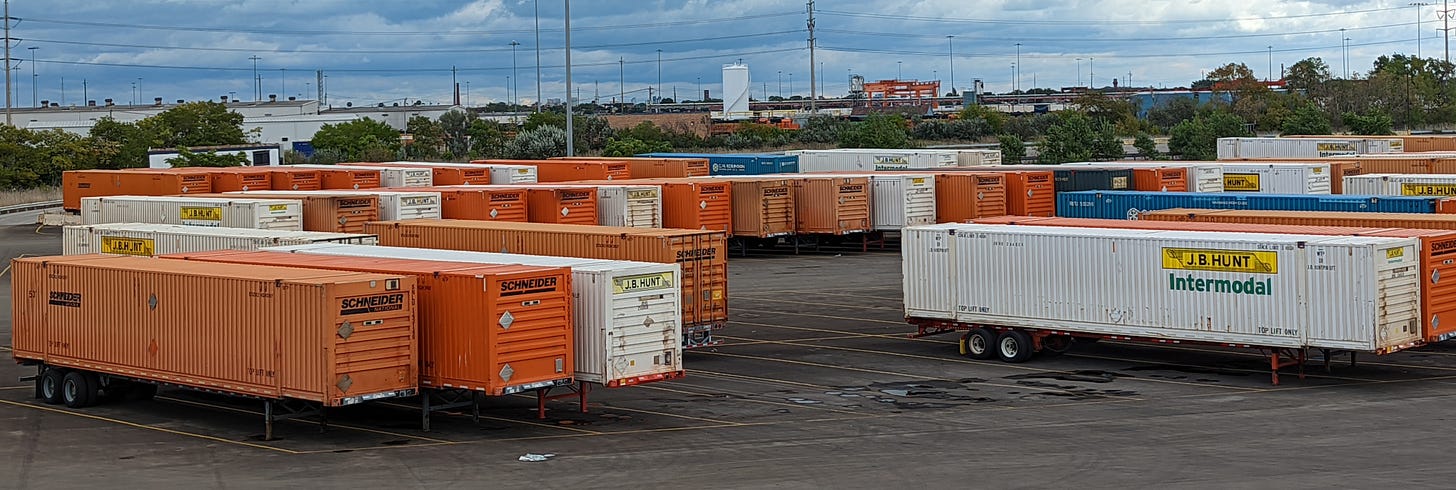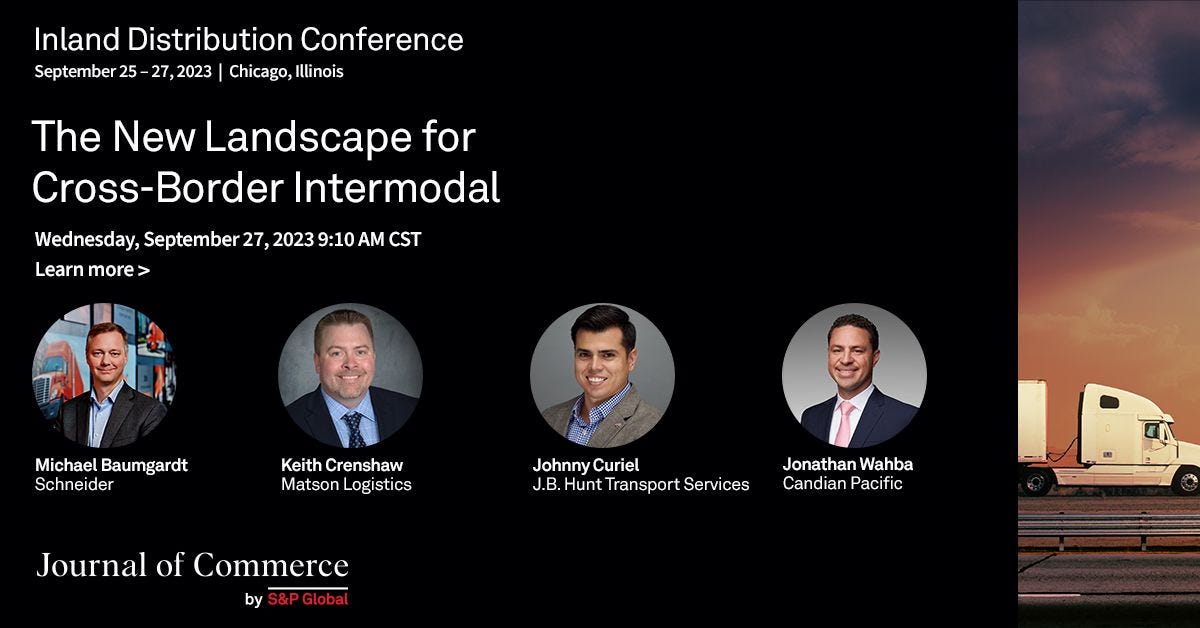Welcome Please Haul My Freight: Edition 42. Here are some items in my notebook this week:
WEST COAST PORTS: It’s been a wild week West Coast ports. Remember in 2014 and 2015, it wasn’t so much a strike as it was the local unions doing job actions that created the biggest problems for shippers. The bright spot — if any — is that laden import volume and IPI on the West Coast are down double digits year over year, so the actual impact is more muted than it would have been a year ago.
This chart shows us that if we saw import volumes in Los Angeles and Long Beach of a year ago (orange line), then we’d be in trouble. If we saw international intermodal (IPI) out of the Southwest 18 months ago, then we’d be in trouble. Neither is the case. In my opinion, the depressed volumes mean the impact of the labor actions on the West Coast is not dire.
FMC SHOWDOWN: Shippers using international intermodal should pay attention to a case before the Federal Maritime Commission called M.E. Day v. Hapag Lloyd. The NVO is seeking damages for demurrage charged on 13 containers that were routed through CSX Nashville. CSX operates a wheeled terminal in Nashville but run out of chassis to mount the Hapag containers. The trucker offered to bring in its own chassis to remove the 13 containers, but CSX refused under a “no cherry-picking” policy, yet elected to keep charging penalties. Hapag filed a cross-complaint against CSX because it argues that CSX rendered the containers unavailable, and thus CSX should be held responsible. As Teri Errico Griffis reports, CSX has countered the FMC has no jurisdiction over railroads. It’s an important case because it will set the ground rules on what is reasonable and unreasonable on demurrage at rail ramps and who the FMC can regulate and not regulate.
TRUCKLOAD RATES: The seasonal uptick seen in May happened again this year, according to the DAT Top 50 Dry-Van Rates, excluding fuel (see chart below).
This year it was a combination of the CVSA International Roadcheck and produce season. We know it was produce related because the Journal of Commerce Shipper Truckload Spot Rate Index shows rates rose in all the typical produce states: California, Georgia, Florida, and the Carolinas.
Many think we’ve now hit a bumpy bottom on rates.
As I wrote in this article, analysts believe it’ll be pretty gradual between now and August. Loadsmart thinks a couple of cents up from where we are now, while Breakthrough Fuel thinks a few cents down from where we are now. However, it doesn’t seem like the purple line will catch up with the orange line this year.
INTERMODAL RATES: Contract intermodal rates keep falling just like truckload contracts. Our Journal of Commerce Intermodal Savings Index shows intermodal contracts are down about 8% to 10% nationally, excluding fuel. When including fuel surcharge revenue, rates have fallen about 15% year over year.
Nevertheless, the average shipper is saving less using intermodal. Why? Because the blue line (see chart above) is falling faster than the orange line.
An average intermodal contract saved 35% nationally compared with truckload last year, but only saves about 25% today. Intermodal saves a lot of money exiting California right now, both Los Angeles and Lathrop/Stockton. Truckload is extremely competitive on local loads staying east of the Mississippi, or west of the Rockies. For example, an Atlanta to Elizabeth (NJ) load is pretty much even between the modes.
Meanwhile, Todd Tranausky of FTR Intelligence predicts intermodal will struggle to compete with trucking into 2024.
INTERMODAL SERVICE: Intermodal train speeds are higher than a year ago and on-time performance is also better, according to the US Surface Transportation Board.
For those who read our domestic Intermodal Service Scorecard Spring 2023 edition, you know CSX and J.B. Hunt Transport Services were voted as the top domestic intermodal providers in early 2023. A majority of shippers and IMCs said domestic intermodal service is heading in the right direction.
Our next Intermodal Service Scorecard will launch in September. If you are a shipper or an IMC, then you are welcome to anonymously participate.
Our scorecard is like an Angi’s or Home Advisor for domestic intermodal. Instead of reviewing a plumber or HVAC person, however, people review intermodal providers.
Click the link below to participate:
Anyone familiar with the names in this photo above is encouraged to participate:
SCHNEIDER: Schneider National has opened an electric charging depot at its South El Monte Intermodal Operations Center in Southern California, enabling the powering of its battery-electric truck fleet. The charging site is capable of charging 32 trucks simultaneously. Schneider will be on our panel at the JOC Inland Conference talking about lowering carbon emissions in trucking.
Schneider also released a paper on Mexico-US cross-border freight, a topic the company will also discuss at our conference.
Click the photo to register and use code “AASUBSTACK20” for a special reader Substack discount!
TALKING: The UBS Industrials & Transports Conference was earlier this week. While I did not attend, I do note some highlights from Tom Wadewitz, UBS’s transportation analyst:
CSX: International intermodal seems to have carved out a bottom and if volumes hold there is potential for better y/y performance in 4Q against easier comps.
CN: CN provided constructive commentary indicating they anticipate improvement in their international intermodal volumes in June (vs May) and they also anticipate much better y/y performance in intermodal in July when they fully lap the impact from the loss of the CMA-CGM contract in June of 2022. I
Heartland Express: [The company] described the marketplace as coming off two years of the best freight we've ever seen, which needs to be kept in perspective. In 2022, the year progressed with weakness month by month, yet as we approached May of this year…conditions are a little stronger, with June even a touch stronger than May. Similar to other presentations, it was described that we may be bouncing along the bottom.
Werner Enterprises: [The company] indicated that the freight environment is still difficult with some seasonal uptick in 2Q but not enough to call a cycle turn yet.
CONGRATULATIONS: I wanted to congratulate David Marsh who retired last week from Celtic Intermodal (now Uber Freight), and is probably taking a nice vacation somewhere. Also congratulations to Shane Blair, who was named as the head of Swift Intermodal. I also wish the best to Dustin Ohlman who left Swift Intermodal and I hope he lands somewhere soon because he knows a lot about intermodal.
Any opinions in this blog represent the author’s views, not the Journal of Commerce or S&P Global. Any rumors in this notebook are just that: rumors. Unconfirmed. Not news stories.
Do you have an opinion or a subject you’d like me to cover? Email me ari.ashe@spglobal.com to send your thoughts.
You may also request the data behind JOC’s Intermodal Savings Index and JOC’s Shipper Truckload Spot Rate Index, available to people with a JOC Gold-Tier subscription.
Not a Journal of Commerce subscriber? Click here to become one.










